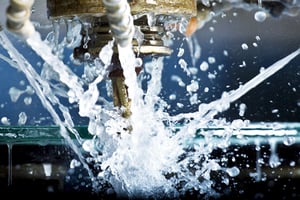Subscribe to our Blog
Purity can be an important measurement for organic solvents, one which an end user will often consider prior to purchase of a solvent. In parts washing applications, purity of an organic solvent is not necessarily the best measurement for effectiveness in application and solvent concentration needs to be carefully considered.
Solvent Purity
The purity of an organic solvent is important for analytical processes and applications, such as with a drug or medicine. It is known in chemical processes it is difficult to achieve 100.00% absolute purity. This is one of the reasons samples are analyzed and monitored in industry, to determine the quality of the given product.
In business, it is also known there usually is a direct relationship between the purity of a given organic solvent and the price or cost of that solvent. That is, as the purity increases, the price or cost of the organic solvent typically will increase as well. For example, the more an organic solvent is processed, the more costly the process and potentially purer the product can become. Within this context, somewhere a compromise is found, meaning the balance between the need for additional product processing and the economics of the end product used in a given application.
Solvent Concentration in Parts Washing
In parts washing applications, concentration is an important factor. In chemistry, the word concentration relates to the amount of a component in a given area or volume. Concentration can refer to a measure of the amount of dissolved substance contained per unit of volume. Another definition of concentration is the ratio of solute in a solution. While usually applied to chemical solutions, concentration may be calculated for any mixture.
Many people have a qualitative idea by what is meant by concentration. For example, anyone who has made instant coffee or lemonade knows that too much powder gives a strongly flavored, highly concentrated drink, while too little powder results in a dilute solution that's hard to distinguish from water. In chemistry, the concentration of the solution is the quantity of a solute contained in a particular solvent or solution. Knowing the concentration of solutes is important in controlling the stoichiometry of reactants for solution reactions.
This same example applies to parts washing applications. The beginning concentration of the solvent is critical (as differentiated from the purity of the solvent). The reason the concentration of the solvent in solution is important is because the concentration percentage (of the organic solvent) provides for capacity of that organic solvent to absorb impurities in parts washing. The concentration of the solvent enables the solvent to absorb the impurity (i.e., waste), thereby removing the waste from the parts that are being cleaned, cleaning those same parts.
Solvent Solubility and Saturation
The maximum amount of a solute (substance) that can be dissolved in a solvent at a given temperature is its solubility. Such a solution with the maximum possible amount of solute is called saturated. By dividing the mass of a compound by the mass of a solvent and then multiplying by 100 g will calculate the solubility in g/100 g.
In fact, a solvent used in parts washing applications will work for a period of time until that solution becomes saturated. As the solvent is used more than once, the solvent will continue to absorb the waste that is being removed from the parts. As the solvent is cycled through this parts washing process, the solvent will continue to absorb more waste and with each successive pass will become slower (less effective) in the parts washing application, until it becomes fully saturated.
Examples of factors that can affect the saturation of waste in parts washing into an organic solvent include:
- Surface area of a solid: In general, finely divided solids have greater solubility.
- Temperature: For an increase of temperature, solubility generally increases. For a decrease in temperature, solubility generally decreases.
- Polarity: In most cases, solutes dissolve in solvents that have a similar polarity.
Therefore, the concentration of a solution which provides for the removal of waste in a parts washing application is critical (while addressing the factors noted above). Adequate concentration of solvent provides for capacity to remove the waste from the parts being washed. This, coupled with the solubility characteristics of the waste into the solvent enables the solvent to remove/absorb waste from the parts. As long as there is adequate concentration of the solvent available, it will (effectively) clean the parts in a parts washing application. One way for end users to provide adequate concentration is to periodically clean their solvent through the process of distillation. This distillation process is important to maintain clean solvent, thereby keeping the concentration high along with its capacity to absorb soluble waste into that organic solvent solution.
In summary, both purity and concentration have relevance when considering the purchase of an organic solvent. In parts washing, concentration is often a more critical measure when considering the impact and the effectiveness of an organic solvent to clean parts. With appropriate concentration of a clean solvent, this will enable the parts to be cleaned. An organic solvent can effectively be recycled and cleaned for recovery through the process of distillation for reuse in your parts washing application.
Learn More
For these reasons, ranging from strategic to tactical, it’s important to evaluate the security of your supply chain for organic solvents with the use of our production recyclers. CBG Biotech's industrial business development executives stand ready to meet your needs for recovering your own organic solvents with SolvTrue™ production recyclers. If you have a question or would like more info, please call 800-941-9484 (and press option 3 for support) or get in touch with us online today!
Check out these other helpful resources:
- Blog Post: Recycling IPA for 3D Printing with SolvTrue™
The benefits of using SolvTrue™ Solvent Recyclers to recover industrial organic solvents in order to increase production capacity. - Blog Post: The Essentials of Solvent-Based Parts Washing Explained
Solvent-based parts washing is one of the most common practices in manufacturing. Learn the role industrial parts cleaning equipment plays in it and more. - Video: About CBG Biotech
At CBG Biotech, we tailor our industry-leading solvent recycling solutions to offer safety, automation, sustainability, cost savings and—most importantly—improved quality throughput to our customers’ critical lab and industrial applications.



COMMENTS